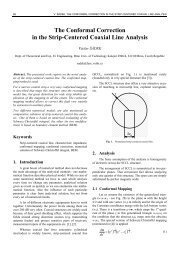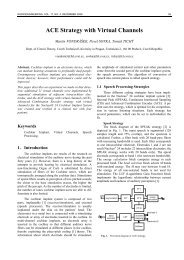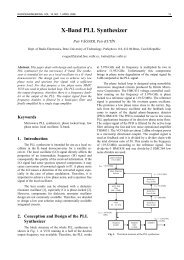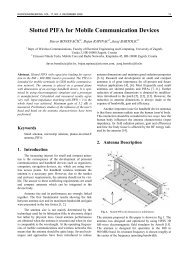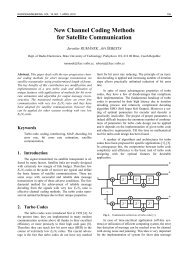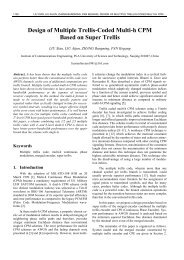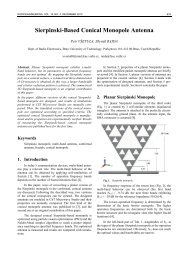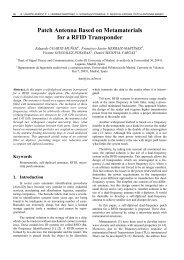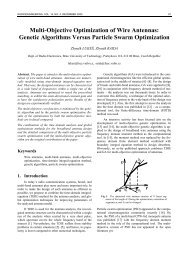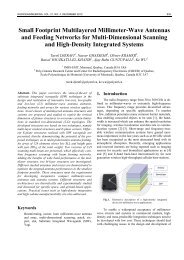An Introduction to Free-space Optical ... - Radioengineering
An Introduction to Free-space Optical ... - Radioengineering
An Introduction to Free-space Optical ... - Radioengineering
You also want an ePaper? Increase the reach of your titles
YUMPU automatically turns print PDFs into web optimized ePapers that Google loves.
RADIOENGINEERING, VOL. 19, NO. 2, JUNE 2010 203<br />
<strong>An</strong> <strong>Introduction</strong> <strong>to</strong> <strong>Free</strong>-<strong>space</strong> <strong>Optical</strong> Communications<br />
Hennes HENNIGER 1 , Otakar WILFERT 2<br />
1 Institute of Communications and Navigation, German Aero<strong>space</strong> Center (DLR), 82230 Wessling, Germany<br />
2 University of Technology Purkynova 118, CZ-61200 Brno, Czech Republic<br />
Abstract. Over the last two decades free-<strong>space</strong> optical<br />
communication (FSO) has become more and more interesting<br />
as an adjunct or alternative <strong>to</strong> radio frequency communication.<br />
This article gives an overview of the challenges<br />
a system designer has <strong>to</strong> consider while implementing an<br />
FSO system. Typical gains and losses along the path from<br />
the transmitter through the medium <strong>to</strong> the receiver are introduced<br />
in this article. Detailed discussions of these <strong>to</strong>pics<br />
can be found in this special issue of the <strong>Radioengineering</strong><br />
Journal.<br />
Keywords<br />
<strong>Free</strong>-<strong>space</strong> optical communications, link budget, turbulence,<br />
fading.<br />
1. <strong>Introduction</strong><br />
<strong>Free</strong>-<strong>space</strong> optical communication (FSO) systems (in<br />
<strong>space</strong> and inside the atmosphere) have developed in response<br />
<strong>to</strong> a growing need for high-speed and tap-proof communication<br />
systems. Links involving satellites, deep-<strong>space</strong> probes,<br />
ground stations, unmanned aerial vehicles (UAVs), high altitude<br />
platforms (HAPs), aircraft, and other nomadic communication<br />
partners are of practical interest. Moreover, all<br />
links can be used in both military and civilian contexts. FSO<br />
is the next frontier for net-centric connectivity, as bandwidth,<br />
spectrum and security issues favor its adoption as an adjunct<br />
<strong>to</strong> radio frequency (RF) communications [1].<br />
While fixed FSO links between buildings have long<br />
been established and <strong>to</strong>day form a separate commercial<br />
product segment in local and metropolitan area networks<br />
[2], the mobile and long-range applications of this technology<br />
are aggravated by extreme requirements for pointing and<br />
tracking accuracy because of the small optical beam divergences<br />
involved. This challenge has <strong>to</strong> be addressed <strong>to</strong> fully<br />
exploit the benefits of optical links. Furthermore, long-haul<br />
optical links through the atmosphere suffer from strong fading<br />
as a result of index-of-refraction turbulence (IRT) and<br />
link blockage by obscuration such as clouds, snow and rain.<br />
In this article an overview of the challenges a system<br />
designer has <strong>to</strong> respond <strong>to</strong> when implementing an FSO sys-<br />
henniger@ieee.org, wilfert@feec.vutbr.cz<br />
tem is provided. Typical gains and losses along the path from<br />
the transmitter through the medium, <strong>to</strong> the receiver are introduced<br />
in this article. Some results concerning the qualitative<br />
parameters of the links and statistical characteristics of the<br />
atmosphere are described.<br />
A more detailed discussion and further information on<br />
these <strong>to</strong>pics can be found in papers in this special issue of<br />
the <strong>Radioengineering</strong> Journal.<br />
2. Discussion of Selected Modulation<br />
Schemes<br />
The optical carrier can be modulated in its frequency,<br />
amplitude, phase, and polarization. The most commonly<br />
used schemes because of their relatively simple implementation<br />
are amplitude modulation with direct detection and<br />
phase modulation in combination with a (self-)homodyne or<br />
heterodyne receiver.<br />
The technically simplest digital modulation scheme is<br />
amplitude-shift keying (2 ASK). In optical systems it is referred<br />
<strong>to</strong> as on-off keying (OOK). OOK is an intensity modulation<br />
scheme where the light source (carrier) is turned on<br />
<strong>to</strong> transmit a logic ”one” and turned off <strong>to</strong> transmit a ”zero”.<br />
In its simplest form this modulation scheme is called NRZ<br />
(non-return-<strong>to</strong>-zero)-OOK. Besides NRZ also other codes<br />
exist. The most common one besides NRZ is RZ (return<strong>to</strong>-zero)<br />
coding. The advantages of RZ compared <strong>to</strong> NRZ<br />
are its higher sensitivity [3] and the fact that the clock frequency<br />
lies within the modulation spectrum. Unfortunately,<br />
both NRZ and RZ can lead <strong>to</strong> loss of clock synchronization<br />
if long strings of ones or zeros are transmitted. This can be<br />
avoided with other coding systems such as Manchester coding,<br />
which is related <strong>to</strong> RZ but amounts <strong>to</strong> state changes at<br />
the beginning or in the middle of clock cycles - pulse position<br />
modulation. With such a variant of RZ the clock of<br />
the digital signal can easily be recovered. These advantages<br />
come at the cost of a requirement of twice the bandwidth of<br />
NRZ in order <strong>to</strong> fulfill the Nyquist–Shannon theorem. Nevertheless,<br />
it has been shown, for example in [4], [3], that RZ<br />
can also work when using the same bandwidth as for NRZ.<br />
In this case an increase in sensitivity of about 2 dB has been<br />
reported [4].<br />
Furthermore, line codes are often used <strong>to</strong> guarantee that
204 H. HENNIGER, O. WILFERT, AN INTRODUCTION TO FREE-SPACE OPTICAL COMMUNICATIONS<br />
the short time average of the signal (i.e., the ”baseline”) is<br />
constant. This is important because optical amplifiers need<br />
input signals with constant mean power if they work with<br />
control loops <strong>to</strong> guarantee constant mean output power. Further<br />
AC-coupling (high-pass filtering) of the electrical signal<br />
at the receiver will introduce a significant amount of<br />
inter-symbol interference if the average of the signal is not<br />
constant [5]. Therefore 8B10B coding on <strong>to</strong>p of NRZ is<br />
commonly used in fiber systems and can also be applied <strong>to</strong><br />
FSO systems. For 8B10B-NRZ the bandwidth requirement<br />
is only 25 percent more than for NRZ. <strong>An</strong> additional advantage<br />
8B10B coding has is that this coding forces frequent<br />
level changes independent of the input stream. Therefore<br />
the clock of the signal can easily be recovered even if long<br />
strings of ”ones” or ”zeros” are transmitted.<br />
For OOK, the exact wavelength of the carrier and its<br />
phase are irrelevant for the demodulation. The receiver just<br />
directly detects the currently incoming power and compares<br />
it against a certain level. OOK is sensitive <strong>to</strong> amplitude<br />
dis<strong>to</strong>rtion (fading) and propagation through different routes,<br />
while the second one is negligible for clear-sky conditions.<br />
Atmospheric obscuration e.g. in clouds can lead <strong>to</strong> significant<br />
attenuation of the received signal but is less important<br />
for FSO systems operating under clear-sky conditions.<br />
Coherent modulation systems are also used in optical<br />
communications. Usually, a binary coherent modulation<br />
scheme is used. For example binary phase shift keying<br />
(BPSK), where the phase of the coherent laser light is shifted<br />
between two states. Coherent receivers rely on the superposition<br />
of the received light with the light of a local oscilla<strong>to</strong>r.<br />
Instead of the local oscilla<strong>to</strong>r self-homodyne is alo possible.<br />
This is used in differential phase shift keyed (DPSK) systems,<br />
which are less sensitive than BPSK systems. In BPSK<br />
systems typically some kind of optical phase-locked loop is<br />
required, which allows the local oscilla<strong>to</strong>r laser <strong>to</strong> be tuned<br />
exactly <strong>to</strong> the same frequency (or a frequency with a constant<br />
offset) and phase as the received carrier. The sensitivity of<br />
coherent receiver implementations is approximately one <strong>to</strong><br />
two orders of magnitude better than the sensitivity of OOK<br />
systems [6], [7] but at the cost of higher system complexity<br />
and additional sensitivity <strong>to</strong> phase dis<strong>to</strong>rtions of the received<br />
beam.<br />
Generally, an OOK system is more robust with regard<br />
<strong>to</strong> atmospheric dis<strong>to</strong>rtion than a coherent modulation system.<br />
This is because for OOK the information is only encoded in<br />
intensity whereas PSK uses intensity and phase coding. Both<br />
the intensity and the phase of a beam are disturbed in atmospheric<br />
propagation. Further, OOK has mainly been used in<br />
optical fiber communications due <strong>to</strong> its low complexity. Additionally,<br />
many reliable and cost effective components are<br />
available in the market, which is important for the development<br />
of FSO communication terminals. As a result, OOK<br />
systems have been preferred for optical links inside the atmosphere:<br />
they are the primary focus of this article.<br />
Since the electrical signal in OOK receivers is propor-<br />
tional <strong>to</strong> the received optical power, all further calculations<br />
can be carried out based on the statistics of the received optical<br />
power focused on the receiver pho<strong>to</strong>detec<strong>to</strong>r.<br />
3. The <strong>Optical</strong> Link Equation<br />
The overall system performance of a link is quantified<br />
using a link margin derived from the link equation. The optical<br />
link equation is analogous <strong>to</strong> the link equation for any<br />
radio frequency (RF) communication link. Starting with the<br />
transmit power the designer identifies all link degradations<br />
and gains <strong>to</strong> determine the received signal level. The received<br />
signal level is then compared with the sensitivity of<br />
the receiver, thus giving the link margin.<br />
3.1 Channel Without Atmospheric<br />
Disturbance<br />
In this section optical links unaffected by the atmosphere<br />
are discussed. In the basic free-<strong>space</strong> channel the optical<br />
field generated at the transmitter propagates only with<br />
an associated beam spreading loss. For this system the performance<br />
can be determined directly from the power flow.<br />
The signal power received PRx [W] depends on the transmit<br />
power PT x [W], transmit antenna gain GT x, receive antenna<br />
gain GRx, the range loss Gr, and system-dependent losses<br />
Asystem,lin.<br />
PRx = PT x · GT x · Gr · GRx · Asystem,lin. (1)<br />
Assuming a Gaussian beam underfilling the transmit<br />
aperture, the transmit antenna gain GT x is ([8], page 99):<br />
GT x = 32<br />
Θ 2<br />
where Θ [rad] is the full-angle e −2 divergence of the transmit<br />
beam.<br />
The range loss Gr depends on the link propagation distance<br />
L and is given by:<br />
� �2 λ<br />
Gr = . (3)<br />
4π · L<br />
Further, the receive antenna gain, with telescope aperture<br />
diameter (antenna size) D, is given by [6]:<br />
� �2 π · D<br />
GRx = . (4)<br />
λ<br />
The Asystem,lin reflects all the other system-dependent<br />
losses. It includes losses due <strong>to</strong> link misalignment, telescope<br />
losses, losses due <strong>to</strong> splitting out light for tracking systems,<br />
etc.<br />
Because of the absence of atmospheric effects the link<br />
margin Mlink in dB is given by:<br />
Mlink[dB] = PRx,dBm − Sr<br />
(2)<br />
(5)
RADIOENGINEERING, VOL. 19, NO. 2, JUNE 2010 205<br />
where received power PRx,dBm [dBm] must be given on a logarithmic<br />
scale. Sr [dBm] is the required power at the receiver<br />
<strong>to</strong> achieve an expected communication performance,<br />
also called receiver sensitivity. It depends on several constraints,<br />
for example data rate and the required bit error probability.<br />
Sensitivity depends on noise sources influencing the<br />
detection, such as ambient light and electronic noise. Similar<br />
power budget analyses of the link are described in prior publications<br />
[9], [10], [11], [12]. The power balance equation<br />
can be expressed with the help of the power level diagram<br />
[9].<br />
To consider the effects disturbing a link propagating<br />
through the Earth’s atmosphere the link equation (5) must<br />
be extended. The primary atmospheric processes that affect<br />
optical wave propagation are extinction and refractive index<br />
turbulence (IRT). The main problems of optical communication<br />
in the atmosphere are attenuation of optical intensity<br />
and fluctuations of received optical signal. <strong>An</strong> attenuation of<br />
optical intensity is caused by the absorption, scattering and<br />
refraction of optical waves by gas molecules and aerosols<br />
such as fog, snow and rain. Especially for short links heavy<br />
fog is the main fac<strong>to</strong>r that limits the link function. For link<br />
lengths exceeding several hundred meters fluctuations of received<br />
optical signal present a severe problem.<br />
Signal fluctuations of the received signal PRx can in<br />
some time intervals fall below the receiver sensitivity Sr. In<br />
such time intervals a so-called “fade” of the signal occurs.<br />
The effects of atmospheric extinction, atmospheric turbulence<br />
and fades are introduced in the following two sections.<br />
3.2 Atmospheric Extinction Effects<br />
It is well known that clouds, rain, snow, fog, haze, pollution<br />
etc. are atmospheric fac<strong>to</strong>rs that affect our viewing of<br />
distant objects. These same fac<strong>to</strong>rs also affect the transmission<br />
of a laser beam through the atmosphere. As transmission<br />
through clouds or heavy fog or haze is normally not possible,<br />
because attenuation exceeds several tens of dB/km,<br />
this is not discussed in this paper. Nevertheless, the signal<br />
under clear-sky weather conditions is attenuated because of<br />
extinction caused by air molecules and aerosols. The transmittance<br />
T of laser radiation that has propagated over a distance<br />
L is described by the Beer’s law:<br />
T = exp(−αe(λ) · L[km]). (6)<br />
The positive extinction coefficient αe(λ) describes the<br />
extinction level of the medium. It is usually given in km −1<br />
and is commonly available in databases like LOWTRAN<br />
[13] or others like FASCODE , MODTRAN, HITRAN, for<br />
example described in [14]. It turns out that the extinction<br />
is highly wavelength-dependent. Atmospheric trace gases<br />
lead <strong>to</strong> strong and broad absorption bands, each consisting<br />
of a multitude of fine absorption lines. Based on the spectral<br />
distribution of these bands, the so called atmospheric<br />
optical transmission windows with low signal losses of the<br />
propagating beam can be calculated by evaluating thousands<br />
of absorption lines in the spectral range from 0.3 µm <strong>to</strong><br />
14 µm. A description of the atmospheric transmission windows<br />
based on extensive evaluation of various data-bases<br />
[15], [16], [17], is given in Tab. 1 and Fig. 1. It can be<br />
seen that typical terrestrial communication wavelengths like<br />
808 nm (Si detec<strong>to</strong>rs), 1064 nm (Nd-YAG lasers) or 1550 nm<br />
(InGaAs detec<strong>to</strong>rs, erbium-doped fiber amplifiers) are applicable,<br />
whereas 950 nm and 1300 nm are not ideal for FSO<br />
systems.<br />
I II III IV V VI VII VIII<br />
0.30 0.97 1.16 1.40 1.95 3.00 4.5 7.7<br />
0.92 1.10 1.30 1.80 2.40 4.20 5.2 14<br />
Tab. 1. Atmospheric <strong>Optical</strong> Transmission Windows (Window<br />
start- and s<strong>to</strong>p-wavelength given in µm).<br />
In addition <strong>to</strong> absorption, scattering has also <strong>to</strong> be taken<br />
in<strong>to</strong> account. This can be described by the Rayleigh scattering<br />
coefficient [18]. Generally, scattering effects decrease<br />
mono<strong>to</strong>nically with wavelength and altitude.<br />
Even in optical windows some extinction must be considered,<br />
e.g. due <strong>to</strong> Rayleigh scattering. A rough estimate<br />
for the clear-sky extinction is based on the meteorologic parameter<br />
visibility V . This can be given by the Kruse relation<br />
[19], [20]. The Kruse relation, which is modified <strong>to</strong> reflect<br />
the attenuation in decibel per kilometer, is given by:<br />
Ae[dB/km] = 17<br />
V [km] ·<br />
� �q 0.55<br />
≥ 0<br />
λ[µm]<br />
where the exponent q is given by<br />
⎧<br />
⎪⎨ 1.6, if V > 50 km,<br />
(7)<br />
q = 1.3,<br />
⎪⎩<br />
0.585 ·V<br />
if 6 km ≤ V ≤ 50 km,<br />
1 3 , if V < 6 km.<br />
(8)<br />
As well as the Kruse relation there are also other models,<br />
as for example presented by the papers in this issue of the<br />
<strong>Radioengineering</strong> Journal. Further, [21] proposed another<br />
expression for the parameter q, which was given by Kruse as<br />
defined in equation (8). Naboulsi et. al. in their work [22]<br />
developed relations using the atmospheric database FAS-<br />
CODE <strong>to</strong> evaluate the attenuation in the 690 nm <strong>to</strong> 1550 nm<br />
wavelength range.<br />
Coming back <strong>to</strong> the link equation, (5) must be modified<br />
by Ae [dB/km] in order <strong>to</strong> consider extinction effects of the<br />
atmosphere:<br />
Mlink[dB] = PRx,dBm − Sr − L[km] · Ae. (9)<br />
In the near-earth layer, rainfall and snow can also reduce<br />
the link margin and must be considered in the link equation<br />
(9). Several models exist <strong>to</strong> estimate the attenuation due<br />
<strong>to</strong> rainfall and snow. These models can be found for example<br />
in the standardization documents of the International<br />
Telecommunication Union [20].<br />
In addition <strong>to</strong> extinction effects, fading effects produced<br />
by the atmosphere must also be considered. This is<br />
discussed in the following.
206 H. HENNIGER, O. WILFERT, AN INTRODUCTION TO FREE-SPACE OPTICAL COMMUNICATIONS<br />
Fig. 1. Atmospheric transmittance based on absorption analysis using LOWTRAN [13]. A zenith path from 0 km <strong>to</strong> 120 km altitude as well as<br />
the midlatitude summer atmospheric model are assumed. Atmospheric transmission windows are highlighted in grey color.<br />
3.3 Influence of Turbulence<br />
This section is divided in<strong>to</strong> two parts. First physical<br />
beam propagation is discussed. Second the reception process<br />
of a dis<strong>to</strong>rted wave is discussed and the impact on the<br />
communication system is given.<br />
Physical Effects of <strong>Optical</strong> Beam Propagation Through<br />
Random Media: Random variations of the refractive index -<br />
also known as index-of-refraction turbulence (IRT) - of the<br />
Earth’s atmosphere are responsible for wavefront dis<strong>to</strong>rtion.<br />
Thus, if a beam with a longitudinal coherence length of at<br />
least several wavelengths propagates through IRT the intensity<br />
of the original beam profile is redistributed. For example,<br />
a Gaussian-shaped intensity profile is transformed in<strong>to</strong> a<br />
random interference pattern, the so-called intensity speckle<br />
pattern. Cross-sections of the beam before and after propagation<br />
through the atmosphere are shown in Fig. 2. As the<br />
refractive index structure along the path is time dependent<br />
because of the turbulent mixing of refractive index cells, the<br />
spatial intensity distribution at the receiver plane varies. The<br />
temporal variation of intensity observed at an infinitely small<br />
point and the spatial variation of intensity within the receiver<br />
aperture are commonly described as ”scintillation”. The in-<br />
tensity scintillation-index σ 2 I<br />
is the normalized variance of<br />
the intensity and is used as a measure of scintillations. The<br />
scintillation-index is usually evaluated in terms of the β 2 0 -<br />
parameter, which is an analytical measure for the integrated<br />
amount of turbulence along the link path. It shall be noted<br />
-parameter equals<br />
that for weak fluctuations (σ2 I < 0.3) the β20 the Ry<strong>to</strong>v variance. Fig. 3 shows the intensity scintillationindex<br />
σ2 I as a function of β2 0 of a spherical wave1 under general<br />
irradiance fluctuation conditions2 . In strong turbulence<br />
or along long paths the scintillation-index saturates. Saturation<br />
occurs because multiple scattering can cause the incident<br />
wave <strong>to</strong> become increasingly incoherent as it propagates<br />
through the medium. A single source of light can, therefore,<br />
appear as extended multiple sources scintillating with<br />
random phase. When these multiple apparent source fields<br />
are added, the resultant intensity scintillation is limited [24].<br />
Thus, for a low level of turbulence single scattering, which<br />
deflects light from the main beam, causes weak scintillation.<br />
For an increasing amount of turbulence more multiple scattering<br />
occurs. Multiple scattering can deflect light from the<br />
main beam but as turbulence gets stronger is can actually deflect<br />
the light back in<strong>to</strong> the main beam again. Therefore the<br />
scintillation saturates.<br />
For a horizontal path (spherical wave) β2 0 is given<br />
by [25]:<br />
β 2 0 = 0.496 ·C 2 n · k 7/6 · L 11/6 . (10)<br />
1 In the case of mobile links or static links without active pointing and tracking inside the atmosphere we usually deal with spherical waves, because the<br />
transmit-beam divergence has <strong>to</strong> expand above the diffraction-limited value <strong>to</strong> ensure illumination of the partner terminal from an unstable moving platform.<br />
Spherical waves are therefore used as the examples here, but the theory presented is not limited <strong>to</strong> these kinds of waves. The classification of the transmitted<br />
beam as a spherical wave holds when the full e −2 divergence angle Θ in radians is larger than 7.1 · � λ/L, as can be deduced from the theory given in [23],<br />
page 180, by using an arbitrarily chosen classification limit.<br />
2 The non general case is the case when the Ry<strong>to</strong>v approximation holds. This approximation is only true for weak fluctuations. The Ry<strong>to</strong>v approximation<br />
assumes that wave dis<strong>to</strong>rtions caused by the turbulence encountered early on in the propagation path will not have any influence on the dis<strong>to</strong>rtions caused by<br />
turbulence countered further on the propagation path.
RADIOENGINEERING, VOL. 19, NO. 2, JUNE 2010 207<br />
Fig. 2. Laser beam propagation through turbulent atmosphere:<br />
intensity cross-section of the transmit beam (left), intensity<br />
cross-section at the receiver plane (right).<br />
Here, k = 2π is the optical wave number, L [m] is again the<br />
λ<br />
propagation path length and C2 n is the refractive index structure<br />
parameter. C2 n is the structure constant of refractive index<br />
fluctuations and a measure of the turbulence strength,<br />
given in m−2/3 . It depends strongly on the height above<br />
ground ha. Nevertheless, for applications involving propagation<br />
along a horizontal or quasi-horizontal path, C2 n can<br />
be assumed <strong>to</strong> be constant, especially for near-ground links<br />
were the variance in altitude due <strong>to</strong> the Earth’s curvature<br />
is negligible. At near ground level, C2 n values will show<br />
a diurnal cycle, which peaks during midday hours, reaches<br />
near-constant values at night, and has minima near sunrise<br />
and sunset. This behavior is documented by measurements,<br />
which can be found for example in [6], [24], [26].<br />
Fig. 3. Intensity scintillation-index σ 2 I as a function of β2 0 under<br />
genearal irradiance fluctuaion conditions. According <strong>to</strong><br />
equation found in [25], page 39.<br />
The Hufnagel-Vally model [23] provides a model often<br />
used by researchers <strong>to</strong> describe the altitude dependence of<br />
C 2 n(ha) in rural areas. The H-V 5/7 variant of the Hufnagel-<br />
Vally model is given by<br />
C 2 n(ha) =<br />
0.00594 � 21<br />
27<br />
� �<br />
2 ha ·<br />
105 �10 m<br />
m−2/3 �<br />
· exp<br />
+2.7 · 10−16 m−2/3 �<br />
· exp − ha<br />
�<br />
1500 m<br />
+1.7 · 10−14 m−2/3 �<br />
· exp − ha<br />
�<br />
100 m .<br />
− ha<br />
1000 m<br />
�<br />
(11)<br />
Height dependent values of C 2 n based on the H-V 5/7<br />
model are given in Fig. 4. The Hufnagel-Valley model gives<br />
an averaged C 2 n-value for a certain altitude. In reality, C 2 n<br />
shows various small scale variations with altitude. C 2 n profiles<br />
have been studied extensively, and beside the Hufnagel-<br />
Vally model various other theoretical models have been proposed<br />
in the past. They can be found for example in [24],<br />
[23].<br />
IRT above water differs from that above soil due <strong>to</strong> the<br />
fact that energy exchange on the ground is controlled almost<br />
exclusively by molecular conduction. In water, however,<br />
there is an additional exchange of mass and heat transfer at<br />
the air-water interface by convection (vertical sensible heat<br />
flux), advection (horizontal heat flux) and evaporation (lateral<br />
heat flux) [27]. The potential rate of evaporation is determined<br />
by the air-sea temperature difference (ASTD) and<br />
the state of the air. Slight roughness of the water surface<br />
modifies the wind field above water and ocean waves enhance<br />
vertical mixing.<br />
Because of the large thermal capacity of water, it requires<br />
much more energy <strong>to</strong> raise the temperature of a volume<br />
of water than for most soils. Therefore ASTD is smaller<br />
than the temperature difference between most other natural<br />
surfaces. Furthermore, the daily fluctuations of the water<br />
surface temperature will be small. In general, the C 2 n values<br />
above water are smaller than expected above land (compare<br />
Fig. 4) and diurnal variations are less pronounced,<br />
e.g. maximum C 2 n can not everytime be expected at midday.<br />
Majumdar provides in his work [6] a maritime turbulence<br />
profile model for altitudes up <strong>to</strong> 6000 m. Parameter<br />
sets for three cases are provided: best C 2 n(h = 0 m)<br />
= 1 · 10 −16 m −2/3 , median C 2 n(h = 0 m) = 8 · 10 −16 m −2/3 ,<br />
and worst C 2 n(h = 0 m) = 1 · 10 −14 m −2/3 . These cases reflect<br />
the dependence of C 2 n on the condition of the air-sea interface.<br />
The model is in good agreement with the measured<br />
values given in [27]. The medium profile maritime − C 2 n<br />
model, which is valid for ha < 6000 m is given by [6] as<br />
C2 n(ha) =<br />
9.8583 · 10−18 m−2/3 +4.9877 · 10−16 m−2/3 �<br />
· exp − ha<br />
�<br />
300 m<br />
+2.9228 · 10−16 m−2/3 �<br />
· exp − ha<br />
�<br />
1200 m .<br />
(12)<br />
This maritime −C 2 n profile is shown in Fig. 4 in comparison<br />
with the rural H-V 5/7-model. It can be seen that<br />
above 500 m there is not much difference between the two<br />
models, because the influence of the boundary layer is negligible.<br />
A strong and temporarily changing gradient in the<br />
index-of-refraction on the link can cause a deflection of an<br />
optical wave from a straight-line trajec<strong>to</strong>ry. Such a refraction<br />
causes very slow but relatively strong fluctuations in the angle<br />
of arrival of the beam at the receiving aperture. To eliminate<br />
this effect an active beam steering and tracking system<br />
is necessary, even for stationary links.<br />
Reception of Dis<strong>to</strong>rted Wavefront: As given in the preceding<br />
section, atmospheric propagation disturbs the beam<br />
profile, which means that the wavefront of the optical beam<br />
is dis<strong>to</strong>rted. Receiving this dis<strong>to</strong>rted wavefront will cause<br />
signal fading. The fading effect and the necessary margin <strong>to</strong>
208 H. HENNIGER, O. WILFERT, AN INTRODUCTION TO FREE-SPACE OPTICAL COMMUNICATIONS<br />
Fig. 4. Rural C 2 n as a function of hight above ground h according<br />
<strong>to</strong> the Hufnagel-Valley H-V 5/7-model in comparison<br />
with a maritime −C 2 n model.<br />
overcome it are discussed in this section.<br />
In optical receiver systems the energy in the beam is<br />
collected by a receive aperture. We consider circular receiver<br />
apertures defined by the function:<br />
fRx(r,D) =<br />
�<br />
1, if |r| ≤ D 2 ,<br />
0, if |r| > D 2<br />
(13)<br />
where D is the diameter of the receiver aperture. It is typically<br />
in the range of several centimeters <strong>to</strong> tens of centimeters.<br />
r is the radial distance from the optical axis. We assume<br />
long-range communication links, where the optical signal<br />
spot at the receiver plane is several times larger than the aperture<br />
diameter D. In this case the received signal amplitude<br />
equals the integral of optical intensity I(r,t) over area.<br />
�� ∞<br />
PRx(t) = fRx(r,D) · I(r,t)d<br />
−∞<br />
2 r. (14)<br />
The effect of integrating over the intensity reduces the<br />
deleterious effects of scintillation. This reduction is called<br />
aperture averaging. Qualitatively, we can regard the aperture<br />
as consisting of an array of nonoverlapping regions. Within<br />
each region the scintillations are perfectly correlated while<br />
between the regions there is no significant correlation. The<br />
regions are also called speckle. For horizontal paths a rough<br />
estimate for the speckle size at the receiver is given by the<br />
communication wavelength and the link distance: √ L · λ [6].<br />
If the aperture is larger than the speckle size, then uncorrelated<br />
scintillations from many regions will be averaged <strong>to</strong>gether,<br />
thereby reducing the signal dynamics.<br />
The variance of received power σ2 P scaled by the square<br />
of the mean power 〈PRx〉 is called the power scintillationindex.<br />
The ratio of the irradiance flux variance obtained by<br />
a finite-size receiver lens <strong>to</strong> that obtained by a point receiver<br />
is called the aperture-averaging fac<strong>to</strong>r fAA:<br />
fAA = σ2P σ2 , 0 < fAA < 1. (15)<br />
I<br />
The aperture-averaging fac<strong>to</strong>r quantifies the reduction<br />
of scintillation.<br />
Amplitude fading, even if aperture-averaging is taken<br />
in<strong>to</strong> consideration, can be described by statistical models<br />
showing the probability density function (PDF) of the received<br />
signal. <strong>An</strong>alysis presented in [28]-[33] shows that<br />
the log-normal (LN) statistical model generally adequately<br />
describes the amplitude-fading of the received signal. Beside<br />
the LN model several other models have been reported<br />
in the literature, e.g. gamma-gamma [31], [34], [35] or<br />
K-distribution [29], [36], [37], and may provide a better<br />
description in very strong turbulence, but their distribution<br />
functions are mathematically more complicated. Nevertheless,<br />
measurements with real existing systems presented in<br />
[32], [33] confirm, that the LN statistical model adequately<br />
describes the dynamics of the received power signal. Therefore,<br />
in the following LN-fading statistics are discussed.<br />
Generally, the PDF of the received analog signal H is modeled<br />
by the LN distribution:<br />
1<br />
fH LN(h) = �<br />
h · 2πσ2 �<br />
[lnh − µLD]<br />
2<br />
exp −<br />
2σ<br />
LD<br />
2 �<br />
,h > 0 (16)<br />
LD<br />
The parameters of the LN distribution µLD and σ 2 LD are<br />
the mean value and the variance of the underlying normal<br />
distribution, respectively. The expectation value of the LN-<br />
PDF E[H] is also the expectation value of the received signal<br />
E[H].<br />
E[H] = exp(µLD + σ2 LD )<br />
2<br />
(17)<br />
The well known (general) scintillation-index σ2 SI 3 is defined<br />
by<br />
σ 2 SI = Var[H]<br />
.<br />
(E[H]) 2 (18)<br />
It directly depends on LN distribution parameter σ 2 LD<br />
σ 2 SI = exp(2µLD + σ2 LD )(exp(σ2LD ) − 1)<br />
(exp(µLD + 1 2σ2 LD ))2<br />
= exp(σ 2 LD) − 1<br />
(19)<br />
and specifies the LN-PDF fH LN(h). If fH LN(h) models the<br />
distribution of the received power the (general) scintillationindex<br />
σ2 SI must be substituted by the power scintillationindex<br />
σ2 P .<br />
Further, it is operationally satisfac<strong>to</strong>ry <strong>to</strong> substitute in<br />
(16) h = PRx where PRx > 0 and therefore (16) becomes 4<br />
fPRx LN(PRx) =<br />
PRx ·<br />
1<br />
�<br />
2πσ2 �<br />
exp −<br />
LD<br />
PRx [ln 〈PRx〉 − µLD]<br />
2<br />
2σ2 LD<br />
3 The (general) scintillation-index σ2 SI can be replaced by the power scintillation-index σ2 P if the signal H describes the received power PRx or by the<br />
intensity scintillation-index σ2 I if the intensity PDF is given. The power equals the integrated intensity over the receiver aperture; compare (14) .<br />
4 As the area below the probability density function must be equal <strong>to</strong> unity the equation must be normalized by the mean power after the substitution.<br />
�<br />
(20)
RADIOENGINEERING, VOL. 19, NO. 2, JUNE 2010 209<br />
In what follows, all received power values are assumed<br />
<strong>to</strong> be normalized <strong>to</strong> the mean value 〈PRx〉. In this case the<br />
parameters of the LN-distribution for the received power are<br />
given by:<br />
σ 2 LD = ln � σ 2 P + 1 � , (21)<br />
µLD = − σ2LD . (22)<br />
2<br />
In general, based on a knowledge of the received power<br />
distribution fPRx a system outage probability pB can be calculated.<br />
If the communication system is assumed <strong>to</strong> work<br />
properly when the receiving power is greater than the receiver<br />
sensitivity Sr the probability of system outage (fractional<br />
fade time) is a cumulative density function (CDF).<br />
pB(Sr) =<br />
� Sr<br />
fPRx<br />
0<br />
(PRx) dPRx. (23)<br />
The required power margin between the average reception<br />
power 〈PRx〉 and Sr (Sr < 〈PRx〉) must be regarded as an<br />
additional fading loss A f ade of the transmission system.<br />
A f ade[dB] = 10 · lg 〈PRx〉<br />
Sr<br />
≥ 0 (24)<br />
With this threshold approach it is assumed that during<br />
times with PRx below Sr no data reception is possible at all.<br />
This reflects a good-bad-state channel modeling and does<br />
not require a detailed investigation of the specific receiver<br />
performance; the latter would again depend on the modulation<br />
format and individual implementation performance. In<br />
connection with the good-bad-state channel model the fractional<br />
fade time pB can also be called outage probability or<br />
bad-state probability.<br />
If PRx is LN distributed one obtains the fractional fade<br />
time pB based on equation (20) and in analogy <strong>to</strong> [30], [28],<br />
[23].<br />
pB(Sr) = frac [P ≤ Sr] (25)<br />
= 1<br />
� � ��<br />
Sr ln 〈PRx〉 − µLD<br />
1 + erf<br />
(26)<br />
2<br />
√ 2σLD<br />
where erf(.) denotes the error function. To calculate the fading<br />
loss the equation (26) must be solved for<br />
Sr<br />
〈PRx〉 :<br />
�√ Sr<br />
= exp 2σLD · erf<br />
〈PRx〉 −1 (2pB − 1) + µLD<br />
�<br />
. (27)<br />
The fading loss A f ade on a logarithmic scale is therefore<br />
given by<br />
A f ade[dB] �= √2σLD −10lge · · erf−1 �<br />
(2pB − 1) + µLD .<br />
(28)<br />
With the assumption E[PRx] = 1 and the approximation<br />
10lge � 4.343, (28) reduces <strong>to</strong>:<br />
A f ade(σ2 P , pB)[dB] ��<br />
=<br />
−4.343 2ln(σ2 P + 1) · erf−1 (2pB − 1) − 1 2 ln(σ2 �<br />
P + 1)<br />
(29)<br />
Therefore, the fading loss is determined by the power<br />
scintillation-index σ2 P and allowed fractional fade time<br />
pB(Sr).<br />
(29) describes the loss or margin which must be considered<br />
in link design in order <strong>to</strong> obtain a certain fractional<br />
fade time. Therefore, the link equation from (5), (9), respectively,<br />
must be extended by A f ade in order <strong>to</strong> consider IRT<br />
fading:<br />
Mlink[dB] = PRx,dBm − Sr − L[km] · Ae − A f ade. (30)<br />
Fig. 5. Fading loss A f ade vs. power scintillation-index σ 2 P as<br />
a function of fractional fade time pB.<br />
As can be observed in Fig. 5 the fading loss according<br />
<strong>to</strong> (29) can easily exceed 20 dB with typical link requirements<br />
(e.g. with outage probabilities of 10 −6 ). Further, for<br />
moderate outage requirements (> 10 −3 ) with turbulence saturation<br />
and aperture averaging the loss will rarely exceed<br />
13 dB. Saturation means that for long distances the intensity<br />
scintillation index σ2 I is saturated near or somewhat above<br />
unity while the power scintillation-index σ2 P becomes less<br />
than unity because of aperture averaging [33], [28].<br />
Finally, having introduced all the main fac<strong>to</strong>rs disturbing<br />
a free-<strong>space</strong> optical link inside the atmosphere we can<br />
calculate link budget based on (30). <strong>An</strong> exemplary link budget<br />
for a 20 km horizontal link is shown in Fig. 6.<br />
Fig. 6. Exemplary link budget base on link equation (30) [38].<br />
Further we evaluate the influence of IRT induced<br />
fading-loss versus link range. Therefore we chose the fol-
210 H. HENNIGER, O. WILFERT, AN INTRODUCTION TO FREE-SPACE OPTICAL COMMUNICATIONS<br />
lowing link parameter: C 2 n(ha = const.) = 1 · 10 −14 m −2/3 ,<br />
λ = 1550 nm, Θ = 1 mrad, D = 5 cm, pB = 10 −2 ,<br />
PT x = 500 mW, Asystem,lin = 0.5, Ae = 0.2 dB/km, and<br />
a typical receiver sensitivity for a 155 Mbit/s system of<br />
Sr = −43 dBm. Fig. 6 shows the link margins according<br />
<strong>to</strong> (9) and (30). As described earlier, with increasing link<br />
length the integrated amount of turbulence increases. This<br />
first causes the scintillation-index <strong>to</strong> increase steadily, then<br />
a maximum is observed and finally it saturates. As shown<br />
in the lower plot in Fig. 6, the fading-loss according <strong>to</strong> (29)<br />
behaves in a way analogous <strong>to</strong> the scintillation-index. It first<br />
increases, peaks, and is than nearly constant for longer distances.<br />
Fig. 7. Upper plot: Link margin including the effect of fading<br />
cause by IRT in comparison <strong>to</strong> a case without atmospheric<br />
fading. Lower plot: Scintillation-index and<br />
fading-loss versus link distance in comparison <strong>to</strong> the link<br />
margin of the upper plot.<br />
If the basic parameters of the given link are known, it is<br />
possible <strong>to</strong> use (5) and obtain link margin Mlink as a function<br />
of link propagation distance L. Such a relationship represents<br />
the steady state model of the given link. In addition, if<br />
the statistical character of the atmosphere at the chosen installation<br />
site of the link is known, it is possible <strong>to</strong> obtain<br />
the probability of atmospheric attenuation exceeding a given<br />
value that represents the statistical model of the chosen link<br />
installation site. With the help of synthesis of the steady state<br />
model of a given link and the statistical model of the chosen<br />
installation site we can obtain the so-called complex model<br />
of the link. Statistical characteristics of the atmosphere in<br />
some localities in Europe were published in [11].<br />
3.4 Conclusion<br />
A brief survey of the fundamentals of FSO has been<br />
presented in this introduc<strong>to</strong>ry article. This brief survey has<br />
focused on outdoor FSO static optical links and describes<br />
some basic models of the link and some simple models of<br />
the atmosphere.<br />
The advantages of FSO result from the basic characteristics<br />
of a laser beam, especially from its high frequency,<br />
coherency and low divergence, which lead <strong>to</strong> efficient deliv-<br />
ery of power <strong>to</strong> a receiver and a high information-carrying<br />
capacity.<br />
The basic characteristics of a laser beam provide the<br />
following additional advantages of FSO links:<br />
• A narrow beam guarantees high spatial selectivity so<br />
there is no interference with other links.<br />
• The high available bit rate allows them <strong>to</strong> be applied in<br />
all types of networks.<br />
• The optical band lies outside the area of telecommunication<br />
regulation; therefore no license is needed for<br />
operation.<br />
• The small size and small weight of optical terminals enables<br />
links <strong>to</strong> be easily integrated in<strong>to</strong> mobile systems.<br />
Nevertheless, challenges remain. The main problems<br />
of FSO links working outdoors in the atmosphere result from<br />
attenuation and fluctuation of optical signal at a receiver. To<br />
improve reliability, a number of new methods are being applied.<br />
For example, a hybrid FSO/RF system increases link<br />
availability by overcomming attenuation effects. RF transmission<br />
is affected more by rain and optical transmission is<br />
affected more by fog. Further, error protection schemes able<br />
<strong>to</strong> deal with the slow fading typical for FSO links are currently<br />
under development.<br />
After considering all its advantages and disadvantages<br />
it is clear that FSO has good prospects for widespread implementation.<br />
FSO technology is ready for utilization as terrestrial<br />
links, mobile links and satellite links.<br />
Acknowledgements<br />
The authors would like <strong>to</strong> thank Professor Chris<strong>to</strong>pher<br />
C. Davis (University of Maryland) for his help and fruitful<br />
discussions.<br />
The research leading <strong>to</strong> these results has received funding<br />
from the European Community’s Seventh Framework<br />
Programme (FP7/2007-2013) under grant agreement no.<br />
230126 and from the Research programs of the Czech Science<br />
Foundation No. 102/09/0550.<br />
References<br />
[1] DAS, S., HENNIGER, H., EPPLE, B., MOORE, C., RABINOVICH,<br />
W., SOVA, R., YOUNG, D. Requirements and challenges for tactical<br />
free-<strong>space</strong> lasercomm. In IEEE Military Communications Conference<br />
. San Diego (USA), 2008, p. 1 – 10.<br />
[2] WILLEBRAND, H., GHUMAN, B. Fiber optics without fiber. IEEE<br />
Spectrum, 2001, vol. 38, no. 8, p. 40 – 45.<br />
[3] PAUER, M., WINTER, P., LEEB, W. Bit error probability reduction<br />
in direct detection optical receivers using rz coding. Journal of Lightwave<br />
Technology, 2001, vol. 19, no. 9, p. 1255 – 1262.
RADIOENGINEERING, VOL. 19, NO. 2, JUNE 2010 211<br />
[4] LEEB, W., WINTER, P., PAUER, M. The potential of return-<strong>to</strong>-zero<br />
coding in optically amplified lasercom systems. In IEEE Lasers and<br />
Electro-Optics Society 1999 12th <strong>An</strong>nual Meeting LEOS ’99, vol. 1.<br />
San Francisco (USA), 1999, p. 224 – 225.<br />
[5] STREET, A., SAMARAS, K., OBRIEN, D., EDWARDS, D. Closed<br />
form expressions for baseline wander effects in wireless ir applications.<br />
Electronics Letters, 1997, vol. 33, no. 12, p. 1060 – 1062.<br />
[6] MAJUMDAR, A. K., RICKLIN, J. C. <strong>Free</strong>-Space Laser Communications<br />
Principles and Advances. Sew York (USA): Springer, 2008.<br />
[7] DAVID, F. Scintillation loss in free-<strong>space</strong> optic im/dd systems. In<br />
LASE 2004, vol. 5338. San Jose (USA), 2004.<br />
[8] LAMBERT, S. G., CASEY, W. L. Laser Communications in Space.<br />
Bos<strong>to</strong>n (USA): Artech House, 1995.<br />
[9] WILFERT , O., KOLKA, Z. Statistical model of free-<strong>space</strong> optical<br />
data link. Proceedings of SPIE, 2004, vol. 5550, p. 203 – 213. [Online]<br />
Available at: http://link.aip.org/link/?PSI/5550/203/1<br />
[10] WILFERT, O., KOLKA, Z., NEMECEK, J., BIOLKOVA, V. Estimation<br />
of fso link availability in Central European localities. Proceedings<br />
of SPIE, 2006, vol. 6303, p. 63030R. [Online] Available at:<br />
http://link.aip.org/link/?PSI/6303/63030R/1<br />
[11] KOLKA, Z., WILFERT, O., FISER, O. Achievable qualitative parameters<br />
of optical wireless links. Journal of Op<strong>to</strong>electronics and<br />
Advanced Materials, 2007, vol. 9, no. 8, p. 2419 – 2423.<br />
[12] KOLKA, Z., WILFERT, O., KVICALA, R., FISER, O.<br />
Complex model of terrestrial fso links. Proceedings of<br />
SPIE, 2007, vol. 6709, p. 67091J. [Online] Available at:<br />
http://link.aip.org/link/?PSI/6709/67091J/1<br />
[13] KNEIZYS, F. X. Atmospheric Transmittance/Radiance [Microform]:<br />
Computer Code LOWTRAN 6. Bedford (USA): Hanscom<br />
AFB, 1983.<br />
[14] SMITH, F. G., ACCETTA, J. S., SHUMAKER, D. L. The Infrared<br />
& Electro-<strong>Optical</strong> Systems Handbook. Atmospheric Propagation<br />
of Radiation, Vol. 2. SPIE Press, 1993. [Online] Available at:<br />
http://www.scribd.com/doc/13650098/IR-Handbook-Volume-2<br />
[15] EDWARDS, D. P. GENLN2: A General Line-by-Line Atmospheric<br />
Transmittance and Radiance Model. Version 3.0: Description and<br />
users guide (technical report). National Center for Atmospheric Research,<br />
1992.<br />
[16] MAYER, B., SHABDANOV, S., GIGGENBACH, D. Atmospheric<br />
Database of Atmospheric Absorption Coefficients (technical report).<br />
German Aero<strong>space</strong> Center (DLR), 2002.<br />
[17] MAYER, B., KYLLING, A. Technical note: The libradtran software<br />
package for radiative transfer calculations - description and examples<br />
of use.’ Atmospheric Chemistry and Physics, 2005, vol. 5,<br />
no. 7, p. 1855 – 1877. [Online] Available at: http://www.atmoschem-phys.net/5/1855/2005/<br />
[18] HENNIGER, H., GIGGENBACH, D., RAPP, C. Evaluation of optical<br />
up- and downlinks from high-altitude platforms using im/dd. In<br />
LASE 2005, <strong>Free</strong>-Space Laser Communications Technologies XVII.<br />
San Jose (USA), 2005.<br />
[19] KRUSE, P. W., MCGLAUCHLIN, L. D., MCQUISTAN, R. B. Elements<br />
of Infrared Technology: Generation, Transmission and Detection.<br />
New York: Wiley, 1962.<br />
[20] P.1814: Prediction Methods Required for the Design of Terrestrial<br />
<strong>Free</strong>-Space <strong>Optical</strong> Links ITU-R WP3M (technical report). International<br />
Telecommunication Union, 2007.<br />
[21] KIM, I. I., MCARTHUR, B., KOREVAAR, E. J. Comparison<br />
of laser beam propagation at 785 nm and 1550 nm in<br />
fog and haze for optical wireless communications. Proceedings<br />
of SPIE, 2001, vol. 4214, p. 26 – 37. [Online] Available at:<br />
http://link.aip.org/link/?PSI/4214/26/1<br />
[22] NABOULSI, M. A., SIZUN, H., DE FORNEL, F. Fog attenuation<br />
prediction for optical and infrared waves. <strong>Optical</strong> Engineering,<br />
2004, vol. 43, no. 2, p. 319 – 329. [Online]. Available at:<br />
http://link.aip.org/link/?JOE/43/319/1<br />
[23] ANDREWS, L. C., PHILLIPS, R. L. Laser Beam Propagation<br />
through Random Media. SPIE Press, 1998.<br />
[24] KARP, S., GAGLIARDI, R. M., MAORAN, M. S., STOTTS, L. B.<br />
(Eds.) <strong>Optical</strong> Channels: Fibers, Clouds, Water, and the Atmosphere.<br />
Plenum Press, 1988.<br />
[25] ANDREWS, L. C. Field Guide <strong>to</strong> Atmospheric Optics. SPIE, 2004.<br />
[26] GIGGENBACH, D., HENNIGER, H., DAVID, F. Long-term nearground<br />
optical scintillation measurements. In LASE 2003. San Jose<br />
(USA), 2003. [Online] Available at: http://elib.dlr.de/7260/<br />
[27] WEISS-WRANA, K. R. Turbulence statistics in lit<strong>to</strong>ral area. Proceedings<br />
of SPIE, 2006, vol. 6364, p. 63640F. [Online] Available at:<br />
http://link.aip.org/link/?PSI/6364/63640F/1<br />
[28] GIGGENBACH, D., HENNIGER, H. Fading-loss assessment in atmospheric<br />
free-<strong>space</strong> optical communication links with on-off keying.<br />
<strong>Optical</strong> Engineering, 2008, vol. 47, no. 4, p. 046001-1 – 046001-<br />
6. [Online] Available at: http://elib.dlr.de/54181<br />
[29] ANDREWS, L. C., PHILLIPS, R. L., HOPEN, C. Y. Laser Beam<br />
Scintillation with Applications. SPIE <strong>Optical</strong> Engineering Press,<br />
2001.<br />
[30] YURA, H. T., MCKINLEY, W. G. <strong>Optical</strong> scintillation statistics<br />
for ir ground-<strong>to</strong>-<strong>space</strong> laser communication systems. Applied Optics,<br />
1983, vol. 22, no. 21, p. 3353 – 3358, 1983. [Online] Available at:<br />
http://ao.osa.org/abstract.cfm?URI=ao-22-21-3353<br />
[31] VETELINO, F. S., YOUNG, C., ANDREWS, L. Fade statistics<br />
and aperture averaging for gaussian beam waves in moderate-<strong>to</strong>strong<br />
turbulence. Applied Optics, 2007, vol. 46, no. 18, p. 3780<br />
– 3789. [Online] Available: http://ao.osa.org/abstract.cfm?URI=ao-<br />
46-18-3780<br />
[32] EPPLE, B. A simplified channel model for simulation of free-<strong>space</strong><br />
optical communications. Journal of <strong>Optical</strong> Communications and<br />
Networking, 2010, vol. 2, no. 5, p. 293 – 304.<br />
[33] HENNIGER, H., EPPLE, B., HAAN, H. Maritime mobile opticalpropagation<br />
channel measurements. In Proceedings of IEEE International<br />
Conference on Communications 2010. Cape Town (South<br />
Africa), 2010 (in press).<br />
[34] AL-HABASH, M., ANDREWS, L., PHILLIPS, R. Mathematical<br />
model for the irradiance probability density function of a laser beam<br />
propagating through turbulent media. <strong>Optical</strong> Engineering, 2001,<br />
vol. 40, p. 1554 – 1562.<br />
[35] ANDREWS, L. C., PHILLIPS, R. L., HOPEN, C. Y., AL-HABASH,<br />
M. A. Theory of optical scintillation. Journal of the <strong>Optical</strong> Society<br />
of America A, 1999, vol. 16, no. 6, p. 1417 – 1429, 1999. [Online]<br />
Available at: http://josaa.osa.org/abstract.cfm?URI=josaa-16-6-1417<br />
[36] SANDALIDIS, H., TSIFTSIS, T. Outage probability and ergodic capacity<br />
of free-<strong>space</strong> optical links over strong turbulence. Electronics<br />
Letters, 2008, vol. 44, no. 1, p. 46 – 47.<br />
[37] KIASALEH, K. Performance of coherent dpsk free-<strong>space</strong> optical<br />
communication systems in k-distributed turbulence. IEEE Transactions<br />
on Communications, 2006, vol. 54, no. 4, p. 604 – 607.<br />
[38] HENNIGER, H., EPPLE, B. Technical Note: <strong>Optical</strong> Link Budget<br />
Tool (olibut) (technical report). Codex GmbH & Co. KG, 2007.
212 H. HENNIGER, O. WILFERT, AN INTRODUCTION TO FREE-SPACE OPTICAL COMMUNICATIONS<br />
About Authors. . .<br />
Hennes HENNIGER was born in 1978 in Berlin. He received<br />
his Dipl.-Ing. degree from the University of Applied<br />
Sciences, Munich, in 2002, and his Master of Science<br />
degree in 2004. He joined the <strong>Optical</strong> Communications<br />
group of the German Aero<strong>space</strong> Center (DLR) in 2001.<br />
He was project manager of the mobile near ground optical<br />
demonstra<strong>to</strong>r project and of the Kirari <strong>Optical</strong> Downlink <strong>to</strong><br />
Oberpfaffenhofen (KIODO) LEO satellite downlink project<br />
2009. His current research interests are channel modelling<br />
and multi layer error protection techniques <strong>to</strong> overcome fading.<br />
In 2007 he founded the Codex consulting and development<br />
company. Henniger has served as a program committee<br />
member for the SPIE’s conference on free-<strong>space</strong> laser communications<br />
at the Optics and Pho<strong>to</strong>nics symposium since<br />
2008. Henniger is a Member of IEEE.<br />
Otakar Wilfert was born in 1944. He received the Ing.<br />
(M.Sc.) degree in electrical engineering in 1971 and CSc.<br />
(Ph.D.) degree in applied physics in 1984, both from the<br />
Military Academy in Brno, Czech Republic. Currently he<br />
is a professor at the Department of Radio Electronics, Brno<br />
University of Technology. He lectures in the courses ”Quantum<br />
Electronics and Laser Techniques”, ”Op<strong>to</strong>electronics”<br />
and ”Pho<strong>to</strong>nics and <strong>Optical</strong> Communications”. He has investigated<br />
problems of free <strong>space</strong> optical communication under<br />
various grant projects from the Ministry of Education of<br />
the Czech Republic and the Czech Science Foundation. The<br />
main results have been published in prestigious journals and<br />
at significant conferences. Areas of his research interest include<br />
optical communications and laser radar systems. He is<br />
a member of IEEE, SPIE, European <strong>Optical</strong> Society, Czech<br />
and Slovak Pho<strong>to</strong>nics Society and the Official Member of<br />
Commission D (Electronics and Pho<strong>to</strong>nics) of URSI.



